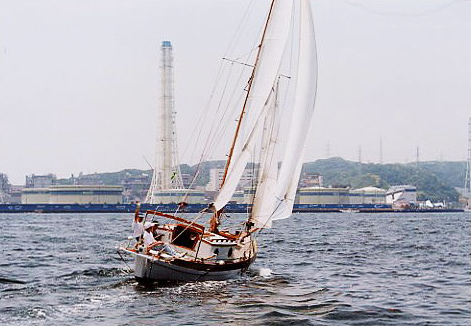 EMILY is sort of a large “pocket cruiser.” The idea was to create a simple and seaworthy boat that was as small as was possible to carry two people, provisions, and personal things on a long cruise.
EMILY is sort of a large “pocket cruiser.” The idea was to create a simple and seaworthy boat that was as small as was possible to carry two people, provisions, and personal things on a long cruise.
You might think that 30′ doesn’t sound very small. But, EMILY is a small 30, if that makes sense. Her length is stretched out to cover a narrow beam and she has fine ends.This makes her hull very easy to wrap material around, and allows her to slip through the water very easily. The result is a boat that will be easier and cheaper to build than many boats 5 to8 foot shorter, but will sail better because she’s longer, and will be more comfortable because the interior is stretched out.
Her interior is set up for two people, and there is no room for overnight guests. Let them sleep on deck!In return you’ll have a boat that’s comfortable for you, with lots of storage, a usable galley, and a comfortable double bunk.
 EMILY’s short deckhouse robs interior room, but that room is just over the bunk where you don’t need standing room anyway, and in return it gives you enough deck to carry areal skiff. Few boats even 10 foot longer can do that, and the ability to carry a real skiff is essential when cruising. Inflatable boats are no good. They don’t row well, they’re expensive, awkward to store and inflate again, fragile, and they get stolen anyway.However, nowhere is the interior carved in stone, so go ahead and change her around if you want to.
EMILY’s short deckhouse robs interior room, but that room is just over the bunk where you don’t need standing room anyway, and in return it gives you enough deck to carry areal skiff. Few boats even 10 foot longer can do that, and the ability to carry a real skiff is essential when cruising. Inflatable boats are no good. They don’t row well, they’re expensive, awkward to store and inflate again, fragile, and they get stolen anyway.However, nowhere is the interior carved in stone, so go ahead and change her around if you want to.
The sail plan is a simple cutter, quite inexpensive to build, very strong, and easily single handed. Her working sails have multiple reefs so she should always be able to fly enough sail to match the conditions. Her working sail area is small, but a large genoa can be carried for light weather use.
The 10 HP diesel is rather in the way, but that can’t be helped. It’s essential to have an installation that gives full access to the coupling and the engine itself. In my opinion it’s better to have no engine than one you can’t maintain.
EMILY can be wood or plywood. I think she’s to light for steel since you’d need to use 1/8″ plate which is hard to work. However, if you want to work out the specs yourself she can be built of steel. I don’t offer plans for steel, but if you want I can send you JUNA’s steel plan so you can see the assembly idea. Plywood makes more sense in this size range. Construction costs should be well under $20,000. I think she could be builtin the northwest, if you scrounged out deals, for under $12,000.
Particulars
LOD: …………………………………….30í
LWL: ……………………………………25′ 1″
Beam: …………………………………….8′ 2″
Draft (loaded): …………………… …..4′ 6″
Displacement (cruising):……………. 10,706 lbs.
Displ./Length ratio (cruising trim).. 302
Prismatic: ………………………………..56
Block: ……………………………………..38
Center of Buoyancy: ……………………5″ aft midsection
Sail Area (working): ……………………423
S.A./Displ. (working): ………………….13.9
Building Plans and Shop Manual are $475.
George Buehler Yacht Design
Box 966,
Freeland, WA 98249
email: buehler@whidbey.com
She’s a tough little ship. A few years ago when that race boat COYOTE was flipped in a storm, drowning her owner Mike Plant, a little EMILY was out in the same storm. She got knocked down which scared the crap out of her mid 60 year old owner, but came through just fine. In fact, one change that wouldn’t hurt her at all is to raise the freeboard about